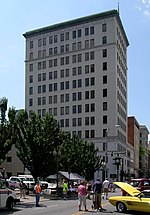Carilion Roanoke Memorial Hospital
1899 establishments in VirginiaBuildings and structures in Roanoke, VirginiaHospital buildings completed in 1899Hospitals in VirginiaRoanoke, Virginia ... and 4 more
Southern United States hospital stubsTrauma centersVirginia TechVirginia building and structure stubs

Carilion Roanoke Memorial Hospital (CRMH) is a private teaching hospital in Roanoke, Virginia, USA. With 703 beds, Carilion Roanoke Memorial Hospital is one of the largest hospitals in the state. It is part of Carilion Clinic.The region's only level I trauma center, the hospital operates three medical helicopters (LifeGuard 10, 11, and 12) to provide air ambulance transport, including one in Moneta, one in Christiansburg, and one in Lexington.
Excerpt from the Wikipedia article Carilion Roanoke Memorial Hospital (License: CC BY-SA 3.0, Authors, Images).Carilion Roanoke Memorial Hospital
Church Avenue Southwest, Roanoke
Geographical coordinates (GPS) Address Nearby Places Show on map
Geographical coordinates (GPS)
| Latitude | Longitude |
|---|---|
| N 37.270833333333 ° | E -79.9425 ° |
Address
Church Avenue Garage
Church Avenue Southwest 121
24011 Roanoke
Virginia, United States
Open on Google Maps










